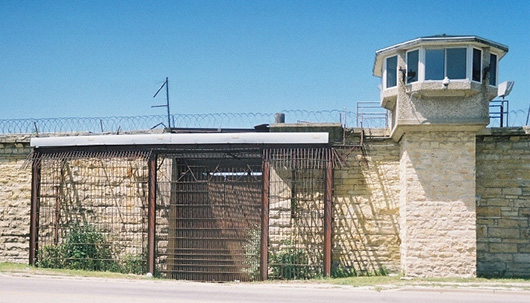JOLIET, Ill. (AP) – It’s never too late to mend, but you only have until March 22 to see how it’s been done locally.
A temporary exhibit at the Joliet Area Historical Museum uses photographs and artifacts from former prisoners, guards and wardens to show the history of the Joliet Correctional Center on Collins Street, the adjacent Women’s Prison and Stateville.
The exhibit shares its title with an 1856 novel by Charles Reade about a man locked up for a crime he didn’t commit. It’s Never Too Late to Mend also is painted on the floor of the Collins Street facility, which was under construction in 1856 and operated until 2001.
“I think we get the most questions about the prisons from visitors,” Executive Director Greg Peerbolte said. While Joliet was nationally known as “a prison town” for decades, city leaders during the rebuilding years of the 1990s wanted to downplay the reputation.
“It’s more of interest now. I think it’s a generational thing. It’s not the only thing (the area is known for) anymore and it’s become part of history to people,” Peerbolte said. “Collins Street was open from before the Civil War to 9/11. That’s a lot of American history.”
When the first prisoners arrived in Joliet in 1858, “it must’ve seemed like a paradise compared to ‘the dungeon’ of Alton, (Ill.)” Peerbolte said.
The women’s “Twin” prison operated separately until 1933, when it became another part of the Correctional Center. Stateville, opened in 1925 when Crest Hill was unincorporated Joliet, houses 3,500 inmates.
Peerbolte said the focus of the exhibit is “reform,” and while some notable inmates are mentioned, there’s no “Hollywood” view of prison life.
“I’d like to think most people in prison deserve to be there and didn’t want anyone who might be a crime victim or related to a crime victim think we were disrespecting them and glorifying the criminals,” Peerbolte said.
Among the exhibits are “the Shankboard” – a collection of common items turned into deadly weapons. Also, there are cell doors and locks from the 19th century, old handcuffs, and a Tommy Gun that Joliet police used while making arrests in the early 20th century.
The exhibits include a noose, too.
“Hangings were actually done at the Will County jail instead of the prison. Invitations were sent out,” Peerbolte said.
The exhibit includes pictures of the deteriorating Collins Street prison as it looks today and asks what should be done with it. Several visitors wrote suggestions to refurbish it as a separate museum or a restaurant.
Mike Johnson has volunteered at the museum for eight years. Johnson was a guard at Joliet Correctional Center from 1984 to 1990 and a counselor there until 1998.
“People always ask about the prison and sometimes I’ve been able to answer their questions from my own (knowledge),” said Johnson, whose uniform is also on display in the exhibit.
In February, Johnson will lecture at the museum on the prison’s history and share his own anecdotes. Peerbolte said the date for that presentation will be finalized soon.
“We’re just known as a prison town from TV and movies,” Johnson said. “People are interested in that.”
___
Source: The (Joliet) Herald-News, http://bit.ly/1BDPwHF
___
Information from: The Herald-News, http://www.suburbanchicagonews.com/heraldnews
Copyright 2015 Associated Press. All rights reserved. This material may not be published, broadcast, rewritten, or redistributed.
AP-WF-01-22-15 0404GMT



